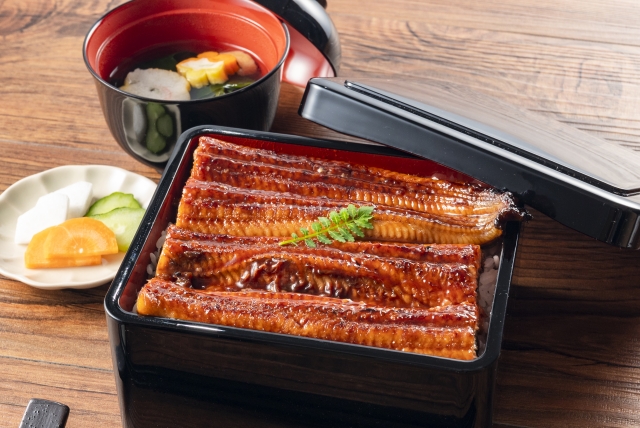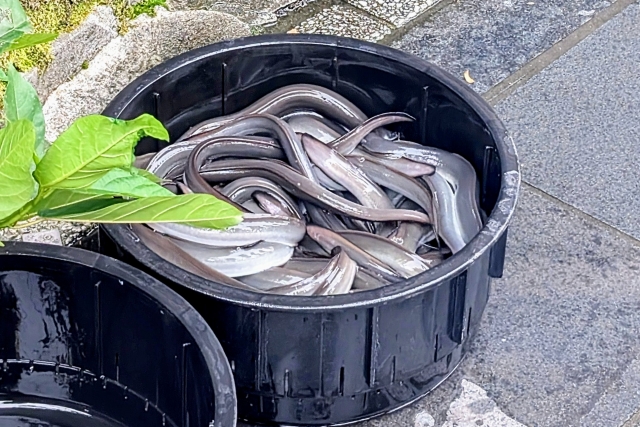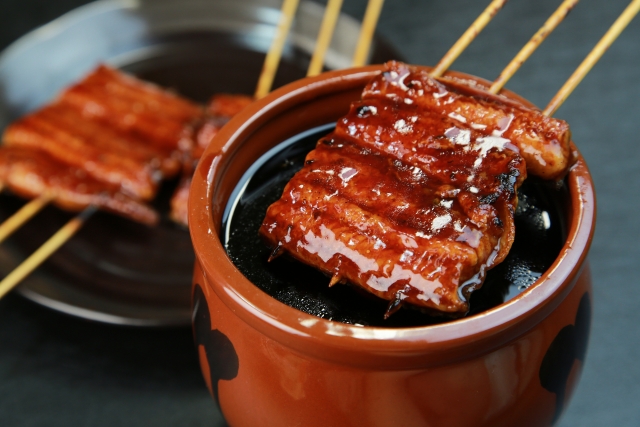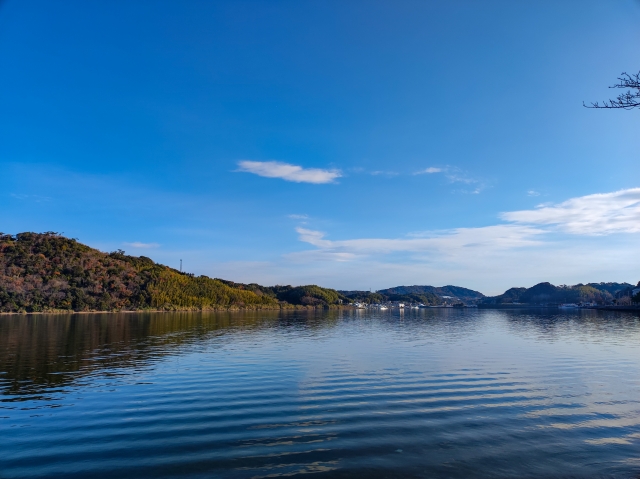
What is “unagi”? A special dish for the Japanese people
Unagi (eel) is a type of freshwater fish with a long, slender body, a traditional ingredient cherished on Japanese tables since ancient times. The custom of eating it on “Doyo no Ushi no Hi” (the day of the ox in midsummer) to build strength during hot summer days continues throughout Japan today. It has become such a symbol of the season that people say, “Summer means unagi.”
The history of eel cuisine dates to the Edo period. For commoners at that time, grilled eel (kabayaki) was the quintessential feast. Even today, dishes like unaju (eel rice box), unadon (eel rice bowl), and hitsumabushi (eel rice served in three ways) are cherished by many Japanese as high-end meals for special occasions.
The reason eel is often called “something you can only eat in Japan” lies in its unique cooking techniques and cultural value. Skilled artisans carefully skewer each eel individually, repeatedly steaming and grilling it to achieve a perfect texture: crispy and fragrant on the outside, tender and fluffy on the inside. The sweet-salty sauce is passed down and replenished over decades, preserving distinct regional flavors.
For Japanese people, eel is not just a fish, but a “feast enjoyed with family and friends to savor the seasons.” It is treated as a special dish eaten during celebrations or while traveling, and in Hamamatsu especially, it is popular as a “highlight of the journey.”
Hamana Lake Unagi: Its Origins and Background

Lake Hamana is renowned as one of Japan’s leading eels farming regions, boasting over 100 years of history. The lake’s water is soft and rich in minerals, creating an ideal environment for eel growth. This blessed natural setting, combined with advanced farming and processing techniques, has established “Lake Hamana Unagi” as a nationally recognized brand.
The Lake Hamana Fish Farming Cooperative Association rigorously manages quality and safety, delivering fresh eel nationwide. In recent years, a new brand called “Deshiko,” focused on female eels, has also emerged. Characterized by its tender, richly fatty flesh, it is gaining attention as a new local specialty.
Hamamatsu Eel: Crafted by Artisans, a Taste Found Only in Japan
Kanto-style vs. Kansai-style: What’s the Difference?
When discussing the appeal of Unagi, the regional “differences in cooking methods” are essential.
Japan broadly has two schools: Kanto-style (Edo-Mae), which steams before grilling, and Kansai-style (Kamigata), which grills directly without steaming. Kanto-style is characterized by a plump, tender texture that melts in your mouth. Kansai-style, grilled over charcoal, offers fragrant, crispy skin.
Located right between the eastern and western cultures, Hamamatsu gave birth to the “Hamamatsu-style,” which incorporates the best of both worlds. Crispy on the outside, fluffy on the inside, this exquisite balance is the true essence of Hamamatsu Unagi.
The journey of an eel to becoming a delicacy
The eel served at Hamamatsu’s renowned restaurants isn’t simply grilled.
It undergoes multiple steps by skilled craftsmen: selection, splitting, skewering, dry grilling, steaming, and glaze grilling. This process resembles fine craftsmanship, inspiring awe even just to watch.
① Selecting the Freshest Eels
Eels delivered from Hamana Lake’s farms are carefully kept in tanks until just before cooking.
“The gleam in their eyes,” “the firmness of their bodies,” “the quality of their slime”—the craftsmen instantly discern quality.
The fresher the eel, the fluffier and more flavorful it becomes when grilled.
② “Slicing” – A Flash of the Knife
When the chef grasps the eel knife, the eel is swiftly slit open from the back (or belly) in a single swift motion.
In the Kanto region, disliking the phrase “to slit open the belly,” the “back-slit” method is mainstream.
Conversely, in the merchant city of Osaka, where the phrase “to speak frankly” is favored, the eel is prepared using the “belly-slit” method.
This cultural difference alters the expression of the dish.
③ “Skewering” — Shaping and Even Cooking
The process of skewering the opened eel onto bamboo skewers.
How the skewers are placed determines the final appearance and texture.
Skewering too tightly toughens the flesh, while too loosely lets the shape collapse. It’s truly a world of “instinct and experience.”
④ “Dry Grilling” — Infusing Charcoal Aroma
First comes “dry grilling” without sauce.
Slowly grilling over binchōtan charcoal’s far-infrared rays removes excess fat and draws out a savory aroma. Heat is adjusted by the second as the chef repeatedly turns the skewers, judging the eel’s thickness and fat content.
⑤ “Steaming” — Achieving Hamamatsu’s signature plumpness
In Hamamatsu, many shops strike a balance between the Kanto region’s “steaming” and the Kansai region’s “direct grilling.”
Light steaming allows the fat to render just right, tenderizing the flesh.
This “balance” is where the chef’s skill truly shines. The Hamamatsu style avoids over-steaming, preserving the grilled aroma.
⑥ “Tare Grilling” — Layering the secret flavor

Finally, the eel is repeatedly grilled while brushed with a sweet-savory sauce. This sauce is a “living flavor,” continuously replenished since the shop’s founding. It blends soy sauce, mirin, sugar, and sake in an exquisite ratio, deepening with time. The cycle repeats: “grill → sauce → grill → sauce.” The moment a glossy sheen appears on the surface, fragrant smoke rises, enveloping the entire shop in a blissful aroma.
⑦ Plating──Completion
The grilled eel is placed atop freshly steamed rice and finished with a drizzle of the final sauce.
Served with ground sansho pepper and liver soup, the “Unaju” embodies the essence of Japanese hospitality.
A blissful dish that satisfies all five senses with its appearance, aroma, and texture.
Various Eel Dishes to Savor in Hamamatsu
In Hamamatsu, you can enjoy not only unaju but also a diverse array of eel dishes.
“Kabayaki” (grilled eel with sauce) is the quintessential classic, letting you savor its fragrant aroma and savory sauce.
“Shiroyaki” (plain grilled eel) brings out the ingredient’s natural flavor; eating it with salt or wasabi highlights the sweetness of its fat.
Additionally, “hitsumabushi”—where chopped eel is mixed into rice—is a popular dish offering three distinct flavors when enjoyed with condiments or broth.
Furthermore, Hamamatsu offers unique menus like “kasane-jū” and “sōshin gozen,” allowing you to compare kabayaki and shirayaki.
Why It’s a Taste Found Only in Japan
Overseas, the culture of cooking eel is virtually nonexistent, and the technique of carefully filleting and grilling each eel individually, as done in Japan, has not been passed down.
What makes Hamamatsu eel special is the perfect integration of:
Premium ingredients born from the natural environment of Lake Hamana
The experience and skill of master craftsmen
Cooking methods rooted in local culture
The deep flavor cultivated by secret sauces
Eating eel is not merely an act of satisfying hunger; it is an experience of savoring Japanese history and artisan culture. Every bite in Hamamatsu is imbued with the weight of time and the pride of the region.


